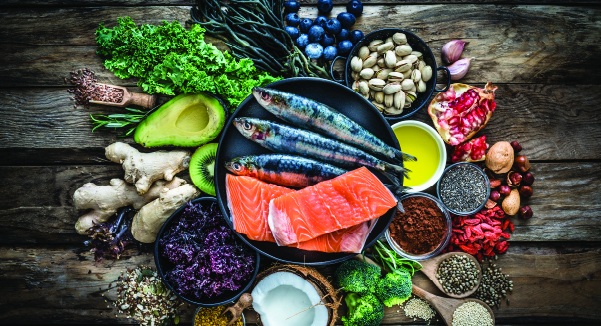Can Increasing Fiber Reduce Inflammation?
Learn how eating a high-fiber diet may help reduce inflammation.
By Linda Rath
Eating a high-fiber diet that includes plenty of nutrient-rich fruits, vegetables, beans, nuts and whole grains can yield many rewards. It might also help lower markers of inflammation — a key factor in many forms of arthritis. Yet most Americans get far less fiber and fiber-rich foods than government guidelines recommend.
Types of Fiber
Our bodies need two types of fiber: soluble and insoluble. Soluble fiber mixes with water to form a gel, which slows digestion. It helps the body better absorb nutrients and may also lower total cholesterol and LDL (“bad”) cholesterol. You’ll find this type of fiber in foods like nuts, seeds, beans, lentils, oat bran and barley. Insoluble fiber helps your digestive system run more efficiently. It adds bulk to stool, which helps prevent constipation. You can get insoluble fiber from sources like vegetables, whole grains, legumes and wheat bran.
The Link Between Fiber and Inflammation
A few studies have found that people who eat high fiber diets have lower C-reactive protein (CRP) levels in their blood. CRP is a marker of inflammation that’s been linked to diseases like rheumatoid arthritis (RA), heart disease and diabetes. It’s not possible to say that eating more fruits, vegetables and other high-fiber foods will help arthritis specifically, but reducing CRP is another good reason to get more fiber, says Dana E. King, MD, professor and chair of family medicine at West Virginia University in Morgantown.
In part, a fiber-rich diet may help reduce inflammation by lowering body weight. High-fiber foods also feed beneficial bacteria living in the gut, which then release substances that help lower levels of inflammation body-wide. Lower inflammation may have to do less with fiber itself than with healthy plant chemicals called phytonutrients found in fiber-rich fruits, vegetables and whole grains.
A 2009 review published in European Journal of Clinical Nutrition reported 25% to 54% lower CRP levels in people who not only ate a high-fiber diet, but who also lost weight and ate more healthy monounsaturated and polyunsaturated fats. In another study, men who ate more fruits and vegetables – going from two servings to eight per day – lowered their CRP levels by one-third. The researchers say the drop was mainly due to eating foods rich in carotenoids, antioxidants that give carrots and oranges their bright color.
Do Fiber Supplements Work?
Americans who don’t get enough fiber naturally in their diet may wonder if fiber supplements have the same effect on inflammation. To find out, Dr. King led a small 2007 study in which people were randomly assigned to either eat a high-fiber diet (about 30 grams per day) or to supplement their diet with psyllium fiber. Higher fiber — whether it came naturally from the diet or from a supplement — lowered CRP levels. However, it didn’t have the same effect in people who were overweight. “CRP went down about 40% in thinner people, but only 10% in people who were overweight,” says Dr. King.
Another larger study Dr. King published the following year also found psyllium supplements didn’t lower CRP levels or other markers of inflammation in overweight or obese people. Why the results were weight-specific isn’t clear. Supplements also don’t provide all the vitamins, minerals and other nutrients in foods that may contribute to reduced inflammation.
Maximizing Your Daily Fiber Intake
Just how much fiber do you need to get the maximum health benefit? Guidelines recommend 20 to 35 grams per day, including both soluble and insoluble fiber. (Most Americans get just 14 grams daily.) At each meal, fill at least one quarter of your plate with whole grains: Foods made with the entire grain kernel, including whole-wheat flour, bulgur, oatmeal, whole cornmeal and brown rice. Another half of your plate should be devoted to fruits and vegetables.
If you’ve been lax about fiber in the past, increase it gradually in your diet. Going straight from 0 to 35 grams a day could lead to uncomfortable symptoms like gas and bloating. And don’t forget to drink plenty of water with your fiber. Water helps fiber work more effectively in your body.
You may have to watch the type of fiber-rich foods you eat. In a small percentage of people, gluten — a protein found in wheat and other grains — may actually set off inflammation. If you think you’re gluten-sensitive and it might be inflaming your joints, talk to your doctor about getting tested for celiac disease or a wheat allergy and consider trying other high-fiber foods instead.

Stay in the Know. Live in the Yes.
Get involved with the arthritis community. Tell us a little about yourself and, based on your interests, you’ll receive emails packed with the latest information and resources to live your best life and connect with others.




